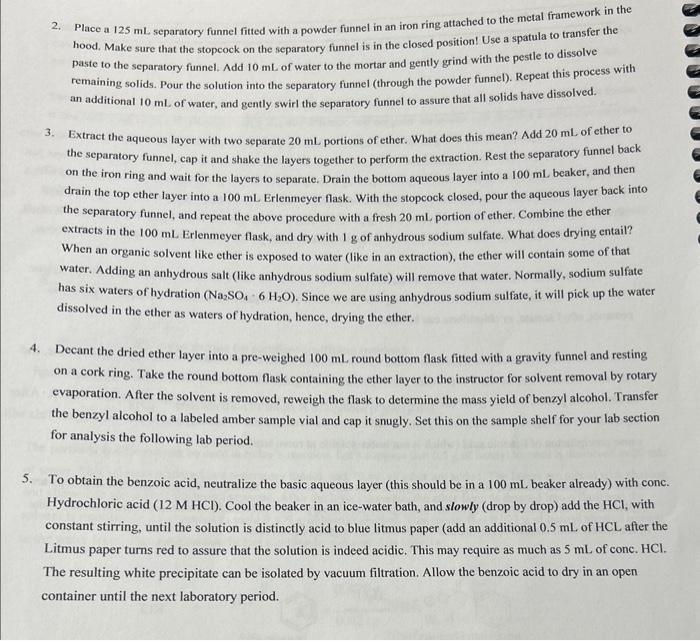Answered step by step
Verified Expert Solution
Question
1 Approved Answer
How to find theoretical yield? Experiment was done with: 2.2g of Potassium Hydroxide 2mL of benzaldenyde The final products were: 1.03g of Benzyl Alcohol 6.28g
How to find theoretical yield? 

Procedure (Week I) 1. Place 2.2g of potassium hydroxide (KOH) in a mortar and grind it into a powder with a pestle. Add to this powder 2 . mL of benzaldehyde. Grind the mixture enthusiastically for 30 minutes; the mixture should turn from a pasto to a sticky, gummy texture. You will have to scrape down the walls of the mortar with a spatula from time to time. Note: Steps 2-5 are diagrammed at the end of the procedure for weck 1 . 2. Place a 125mL separatory funnel fitted with a powder funnel in an iron ring attached to the metal framework in the hood. Make sure that the stopcock on the separatory funnel is in the closed position! Use a spatula to transfer the paste to the separatory funnel. Add 10mL of water to the mortar and gently grind with the pestle to dissolve remaining solids. Pour the solution into the separatory funnel (through the powder funnel). Repeat this process with an additional 10mL of water, and gently swirl the separatory funnel to assure that all solids have dissolved. 3. Extract the aqueous layer with two separate 20mL portions of ether. What does this mean? Add 20mL of ether to the separatory funnel, cap it and shake the layers together to perform the extraction. Rest the separatory funnel back on the iron ring and wait for the layers to separate. Drain the bottom aqueous layer into a 100mL beaker, and then drain the top ether layer into a 100mL Erlenmeyer flask. With the stopcock closed, pour the aqueous layer back into the separatory funnel, and repeat the above procedure with a fresh 20mL portion of ether. Combine the ether extracts in the 100mL Erlenmeyer flask, and dry with 1g of anhydrous sodium sulfate. What does drying entail? When an organic solvent like ether is exposed to water (like in an extraction), the ether will contain some of that water. Adding an anhydrous salt (like anhydrous sodium sulfate) will remove that water. Normally, sodium sulfate has six waters of hydration (Na2SO46H2O). Since we are using anhydrous sodium sulfate, it will pick up the water dissolved in the ether as waters of hydration, hence, drying the ether. 4. Decant the dried ether layer into a pre-weighed 100mL round bottom flask fitted with a gravity funnel and resting on a cork ring. Take the round bottom flask containing the ether layer to the instructor for solvent removal by rotary evaporation. After the solvent is removed, reweigh the flask to determine the mass yield of benzyl alcohol. Transfer the benzyl alcohol to a labeled amber sample vial and cap it snugly. Set this on the sample shelf for your lab section for analysis the following lab period. 5. To obtain the benzoic acid, neutralize the basic aqueous layer (this should be in a 100mL beaker already) with conc. Hydrochloric acid ( 12MHCl ). Cool the beaker in an ice-water bath, and slowly (drop by drop) add the HCl, with constant stirring, until the solution is distinctly acid to blue litmus paper (add an additional 0.5mL of HCL after the Litmus paper turns red to assure that the solution is indeed acidic. This may require as much as 5mL of conc. HCl. The resulting white precipitate can be isolated by vacuum filtration. Allow the benzoic acid to dry in an open container until the next laboratory period Experiment was done with:
2.2g of Potassium Hydroxide
2mL of benzaldenyde
The final products were:
1.03g of Benzyl Alcohol
6.28g of Benzoic Acid
I added the procedure for the experiment for additional information.


Step by Step Solution
There are 3 Steps involved in it
Step: 1

Get Instant Access to Expert-Tailored Solutions
See step-by-step solutions with expert insights and AI powered tools for academic success
Step: 2

Step: 3

Ace Your Homework with AI
Get the answers you need in no time with our AI-driven, step-by-step assistance
Get Started


